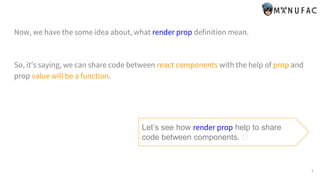React render props
- 1. REACT RENDER PROP By Saikat Samanta
- 2. Knowledge required: 1. Basic of React Js. 2. Typescript Point to note: 1. In this presentation we are going to use typescript to create the examples. 2
- 3. What is render prop? The term “render prop” refers to a technique for sharing code between React components using a prop whose value is a function. So, we have two things here: 1. Sharing code by using prop. 2. Prop value will be a function. Let’s simplify it... 3
- 4. Sharing code by using Prop // Child component export function Component(props: { name: JSX.Element}) { return <div>{props.name}</div>; } // Parent component export default function App() { return ( <div className="App"> <Component name={<p>John</p>} /> </div> ); } 4
- 5. Prop value will be a function // Child component export function Component(props: { name: () => JSX.Element }) { return <div>{props.name()}</div>; } // Parent component export default function App() { return ( <div className="App"> <Component name={() => <p>John</p>} /> </div> ); } 5
- 6. Prop value will send from child component // Child component export function Component(props: { name: (name: string ) => JSX.Element }) { return <div>{props.name("John")}</div>; } // Parent component export default function App() { return ( <div className="App"> <Component name={(name) => <p>{name}</p>} /> </div> ); } 6
- 7. Now, we have the some idea about, what render prop definition mean. So, it’s saying, we can share code between react components with the help of prop and prop value will be a function. Let’s see how render prop help to share code between components. 🤔 7
- 8. Let’s take an example: We have two tasks: 1. We need to implement a component which will count how many times a button clicked. 2. We have a header and it will count how many times we hover on it. 8
- 9. 1. Button click counter: // Child component export function ClickCounter() { const [count, setCount] = useState(0); const addCount = () => { setCount(prevCount => prevCount + 1); } return ( <div> <button onClick={addCount}> You click {count} time </button> </div> ); } // Parent component export default function App() { return ( <div className="App"> <ClickCounter/> </div> ); } repeated code 9
- 10. 2. Hover counter // Child component export function HoverCounter() { const [count, setCount] = useState(0); const addCount = () => { setCount(prevCount => prevCount + 1); } return ( <div onMouseEnter={addCount}> <p>Hover {count} times</p> </div> ); } // Parent component export default function App() { return ( <div className="App"> <HoverCounter/> </div> ); } repeated code 10
- 11. Here, we are repeating a code block in both component. To avoid this situation `render prop`comes into picture. By using `render prop` we will share the same piece of code with both components. Let’s see … 🤔 11
- 12. Remove the repeated part: Removed the repeated part and replace with props in ClickCounter. export function ClickCounter({ count, onClick, }: { count: number; onClick: React.MouseEventHandler<HTMLButtonElement>; }) { return ( <div> <button onClick={onClick}>You click {count} time</button> </div> ); } 12
- 13. Remove the repeated part: Removed the repeated part and replace with props in HoverCounter. export function HoverCounter({ count, onMouseHover, }: { count: number; onMouseHover: React.MouseEventHandler<HTMLDivElement>; }) { return ( <div onMouseEnter={onMouseHover}> <p>Hover {count} times</p> </div> ); } 13
- 14. Create a common counter component: export function Counter(props: { render: (count: number, addCount: () => void) => JSX.Element; }) { // Count logic const [count, setcount] = useState(0); const addCount = () => { setcount((prevState) => prevState + 1); }; // End logic return <div>{props.render(count, addCount)}</div>; } 14
- 15. Let’s use the common counter: Let’s use the common counter component in parent component. export default function App() { return ( <div className="App"> <Counter render={(count, setCount) => ( <ClickCounter count={count} onClick={setCount} /> )} /> <Counter render={(count, setCount) => ( <HoverCounter count={count} onMouseHover={setCount} /> )} /> </div> ); } 15
- 16. Result: Here, we don’t repeat the same code but both components are working as expected. 16
- 17. Conclusion: 1. `Render props` will be very helpful to avoid code repetition. 2. We can share code in any level of component tree no need to be a direct child. 3. This will help to write code in more organized way without code repetition. 17
- 18. Reference: 1. https://reactjs.org/docs/render-props.html 2. https://blog.logrocket.com/react-reference-guide-render-props/ 3. https://flexiple.com/react/render-props-an-advanced-react-pattern/ 18
- 19. Question? ♂️ 19
- 20. Thank you... 20









![1. Button click counter:
// Child component
export function ClickCounter() {
const [count, setCount] = useState(0);
const addCount = () => {
setCount(prevCount => prevCount + 1);
}
return (
<div>
<button onClick={addCount}>
You click {count} time
</button>
</div>
);
}
// Parent component
export default function App() {
return (
<div className="App">
<ClickCounter/>
</div>
);
}
repeated code
9](https://image.slidesharecdn.com/reactrenderprops-211113061108/85/React-render-props-9-320.jpg)
![2. Hover counter
// Child component
export function HoverCounter() {
const [count, setCount] = useState(0);
const addCount = () => {
setCount(prevCount => prevCount + 1);
}
return (
<div onMouseEnter={addCount}>
<p>Hover {count} times</p>
</div>
);
}
// Parent component
export default function App() {
return (
<div className="App">
<HoverCounter/>
</div>
);
}
repeated code
10](https://image.slidesharecdn.com/reactrenderprops-211113061108/85/React-render-props-10-320.jpg)



![Create a common counter component:
export function Counter(props: {
render: (count: number, addCount: () => void) => JSX.Element;
}) {
// Count logic
const [count, setcount] = useState(0);
const addCount = () => {
setcount((prevState) => prevState + 1);
};
// End logic
return <div>{props.render(count, addCount)}</div>;
}
14](https://image.slidesharecdn.com/reactrenderprops-211113061108/85/React-render-props-14-320.jpg)





